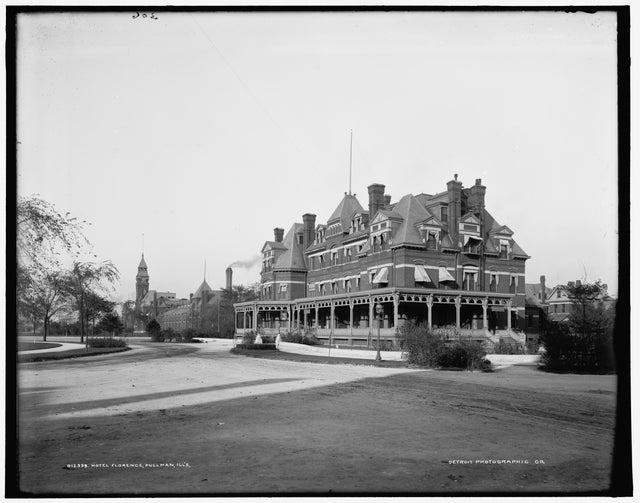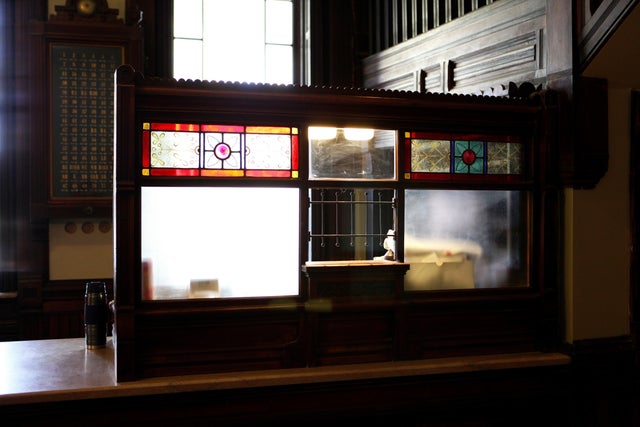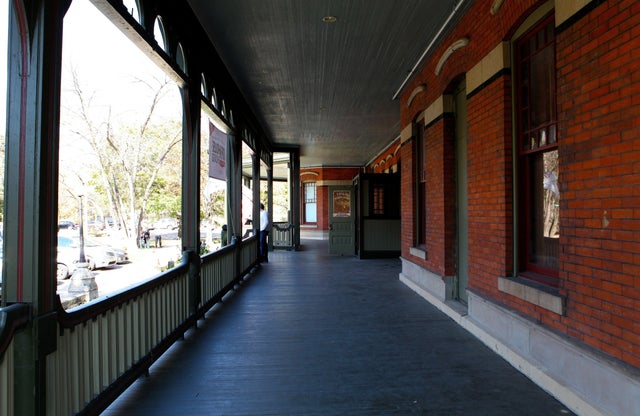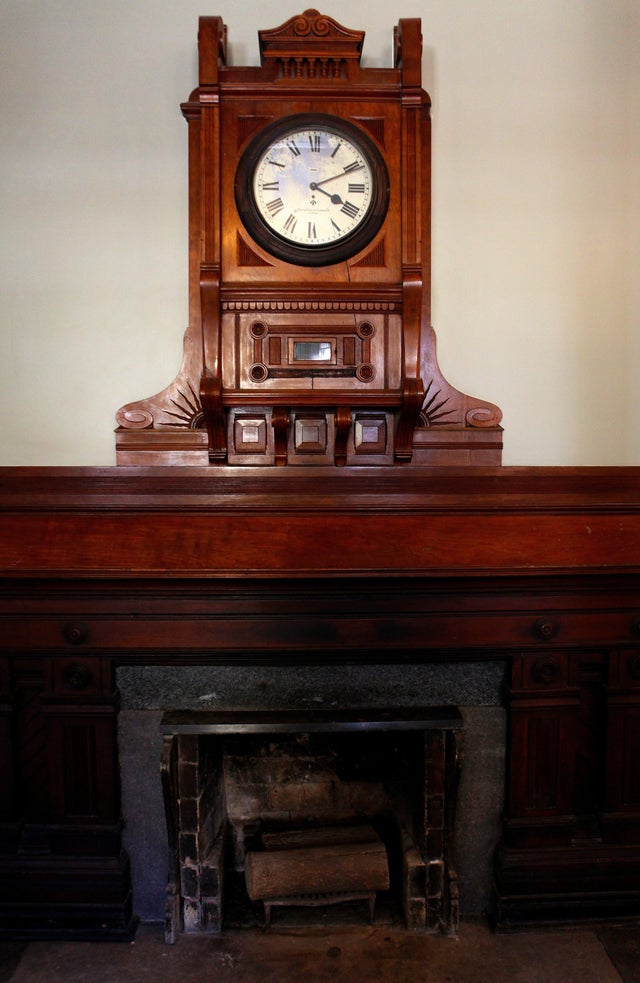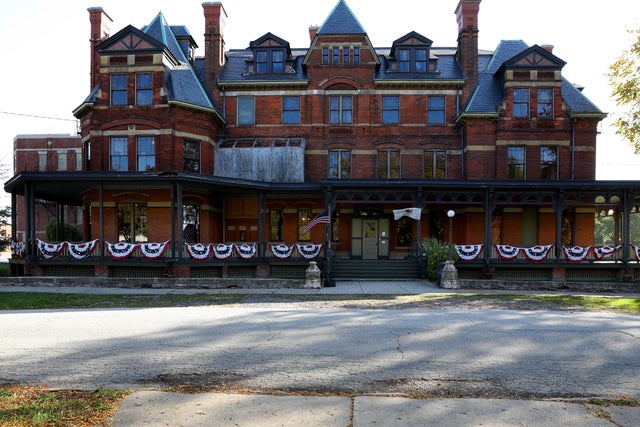Chicago Hauntings: Spirits at the once-proud Hotel Florence in the Pullman District
The Pullman Palace Car Company is up there with the Union Stockyards and the steel mills of the Southeast Side when it comes to Chicago industrial history.
As host Mary Jane Hayes put it in a May 1980 edition of Channel 2's "It's Worth Knowing," the company built train cars that spared no luxury — "opulent, splendid and sumptuous, streets upholstered in red mohair, cabinet work of mahogany, oak and satinwood."
The center of operations was a company town on what is now Chicago's Far South Side, but at the time lay outside the city limits. The town was completed in 1884 between Lake Calumet and the Illinois Central railway tracks, with more than 1,000 homes and public buildings in addition to its central railcar factory.
The railcar company brought in architect Solon Spencer Brenn and landscape architect Nathan Barrett to design the town, which also housed workers in homes with indoor plumbing and alley garbage collection, churches, schools, factory shops, and a theater called the Arcade.
The town also featured a 23,000 square-foot hotel at what is now 11111 S. Forrestville Ave. The Hotel Florence is named not for the lovely Italian city of Michaelangelo's David and Il Duomo, but for Pullman Palace Car Company founder George M. Pullman's favorite daughter.
The hotel was completed on Nov. 1, 1881, and cost $100,000 to build at the time, according to the Historic Pullman Foundation, or about $3.18 million in today's dollars.
The interior of the hotel was bedecked in fixtures and furnishings worth more than $30,000, or about $953,000 today, the foundation said.
When it opened, the hotel had 50 sleeping rooms, a dining room, a billiard room, a barbershop, separate men's and women's parlors, and a bar — the only site where liquor could be sold in the whole town of Pullman, the foundation said.
The building had gaslights with electric spark ignition, and heat from radiators using steam generated by a Corliss Engine across the street, according to the foundation. The first floor featured cherry woodwork and multicolored stained-glass windows, an office counter of Tennessee marble, and large open fireplaces, according to historical accounts.
Pine woodwork was found elsewhere in the hotel.
Pullman also kept his own chambers in the hotel. His home was a mansion in the Prairie Avenue District, in what we would now call the South Loop.
The elegant second-floor rooms featured Eastlake furniture — a style known for being less flamboyant than earlier designs of the Victorian era, but still fashionable and luxurious.
Oh, and legend also has it that the Hotel Florence is full of ghosts.
From exclusive accommodation to white elephant
The Queen Anne-style Hotel Florence with its dormers, gables, pilastered chimneys, and wraparound veranda was not for the Pullman factory workers. They lived in homes they rented from Pullman — handing back the money he had paid them.
In 1893, the country fell into an economic depression. The Pullman Palace Car Company was struggling, and dealt with its woes by lowering wages in response to the drop in demand for train cars. The company did not, however, lower the workers' rents. This led to a strike that culminated in violent riots in 1894, which burned seven buildings left over from the World's Columbian Exposition in Jackson Park one night and more than 7,000 railcars the next day, and led to a violent clash between National Guard troops and rioters along the Grand Trunk railroad tracks in Back of the Yards.
Furthermore, workers who lived in the company town were also subjected to a surveillance state. According to the Chicago Architecture Center, Pullman banned independent newspapers and public discussion forums, had inspectors barge into homes, and terminated leases at the drop of a hat.
Pullman also thought a beer or a shot of whiskey at the end of a long workday was unacceptable for his employees, so he banned the sale of alcohol everywhere within the town limits except the Hotel Florence. However, Pullman workers were not allowed at the bar at the Hotel Florence. It was only for the visiting businessmen and dignitaries who had the privilege of staying at the hotel.
Pullman workers did not cheerfully practice temperance and stand in a line singing, "Away, away with rum, by gum!" According to the Pullman History Site, they went across the Illinois Central Railroad tracks to neighboring Kensington, also known as Bumtown, for adult beverages.
Meanwhile, the National Park Service noted, service at the Hotel Florence mimicked the Pullman Porter model, with Black men working as waiters in the dining room with its elegant china and silver, and Black women working as maids.
The hotel was the only place in the town of Pullman where African Americans worked or were even regularly seen, the National Park Service said.
The Pullman Palace Car Company would one day play a major role in the push for Civil Rights, Led by labor organizer A. Philip Randolph, the majority Black Pullman Porters organized the Brotherhood of Sleeping Car Porters in 1925. But in the Gilded Age of the late 19th century when the Hotel Florence was new, the National Park Service notes that a stark racial hierarchy "further served to embed the practice of being served by Black people into the parameters of industrial-age luxury."
Gilded Age railroad supply mogul "Diamond Jim" Brady, President Ulysses S. Grant, and several notable Europeans ate in the dining room at the Hotel Florence, according to the Pullman History Site.
The hotel's reading room, barbershop, billiard room, bar, and office were also designated "men only," and while there was a ladies' parlor, unaccompanied women could not register as guests themselves and had to use a different door.
As there were no elevators at the hotel, there was also a class distinction between the floors. The rooms on the second floor were first-class, the third floor a step down, and the oddly-shaped rooms on the fourth floor likely fit only for servants who came with their employers to the hotel, the historic site said.
Only the rooms at the end of the hallways on the second and third floors had private bathrooms, the historic site said. Everyone else had to use a shared bathroom down the hall.
The City of Chicago annexed Hyde Park Township — which included all of the South Side east of State Street and south of Pershing Road — in 1889. Most Pullman residents voted against the annexation, and the Pullman Land Association continued to manage town properties, according to Historic Pullman Foundation.
George M. Pullman died in 1897. The following year, the Illinois Supreme Court ordered the Pullman Company to sell all its properties not used for industry, including the company residences and the Hotel Florence. Residents were given the first option to purchase their rented homes, and the process was completed in 1907.
The Hotel Florence was first sold to Herman Getze, who in turn sold it to William Fischer in 1910, according to published reports. A three-story annex was added in 1914, bringing the total number of rooms to 120, according to the National Park Service.
In addition to the hotel and the restaurant, Dick Wibalda (1883-1980), son of a Pullman worker from a Dutch immigrant family, opened a barbershop in the Hotel Florence in 1907. Wibalda was at the helm until he retired in 1960, according to the Chicago Tribune.
The Pullman History site says the Fischer family owned the hotel until 1971, and features images of a matchbook and gambling chips from the establishment. Metal ceilings were installed and fireplaces were closed off after Fischer died and his son took over in 1947, according to the Tribune in 1962. Still, the paper reported a visit to the Hotel Florence was "like stepping back into the 1880s."
Published reports also noted that the Hotel Florence was used for part of the 20th century as a single-room occupancy residence rather than a hotel for short-term guests.
By 1975, the Tribune reported, the Hotel Florence was in a state of decay and disrepair to the point where it was nearly torn down. Historic Pullman Foundation President Michael Shymanski told the newspaper that at the time, "the weather alone could virtually destroy it in a few years."
The Historic Pullman Foundation bought the hotel that year to rescue it from demolition following a fundraising drive and auction of some artifacts inside, the newspaper reported. The roof was replaced in 1980 with funding from a Chicago city block grant, but the foundation sold the hotel to the State of Illinois in 1991 after full restoration efforts did not work out, according to the Chicago Tribune.
The state had hopes of turning the Hotel Florence into a tourist attraction — perhaps a bed and breakfast, published reports noted. But hard times continued for the hotel and the Pullman Historic District as a whole.
In December 1998, an arson fire gutted the Pullman Administration Building and destroyed its majestic tower and clock. A factory building dating back to 1910 was also destroyed. The tower was rebuilt in 2005.
The Hotel Florence was not affected by the fire, but parts of it were crumbling again. In October 2000, the state closed the hotel altogether for a multimillion-dollar repair project.
Foundation spokesman and past president Bob Fiorietti, who later became a Chicago alderman, told the Chicago Sun-Times in 2000 that it had taken the state several months just to repair a restroom, and it was anyone's guess how long it would take to repair everything.
A quarter century later, the Hotel Florence remains closed. But in 2023, the State of Illinois passed a bill to dedicate more than $20 million to the restoration of the hotel, and this year, the Illinois Department of Natural Resources put out a request for proposals for a contractor to restore and operate the hotel for 75 years to come.
A haunted hotel
But you came here to find out about ghosts.
It happens that the Hotel Florence hosted a haunted house event back in October 1986 — where visitors got to go up to the third floor, where creaking floors, flickering lights, ghostly figures, and lurking "monsters" were set up to scare people. The event is preserved on video posted to YouTube.
But there are stories of ghosts at the Hotel Florence that weren't just props or costumed characters for family-friendly parties.
Paranormal expert Tony Szabelski of Chicago Hauntings Tours said there aren't too many stories of hauntings at the Hotel Florence dating back to its early days, but there are many from throughout the decades of restoration work.
Szabelski said workers handling restoration have reported seeing shadowy figures moving around throughout the building. He added that delivery people "would all have weird experiences of seeing something not wanting them on the property and kind of chasing them way from the property."
It reached the point, Szabelski said, where it became something of a joke that drivers for delivery services such as UPS did not want to deliver to the Hotel Florence out of fear of those uncanny disruptions.
Ghosts have even been spotted on the veranda, Szabelski said. They are believed to be the spirits of Pullman workers.
Ghost hunter Ursula Bielski reports the Hotel Florence is also rumored to be haunted by a woman who once lived there.
Could that woman be Florence Pullman herself? She married Chicago attorney and eventual Illinois Gov. Frank O. Lowden and had four children, before she died in 1937 at the age of 68. In a 2017 post on the Pullman Historic District Chicago Facebook page, Jennifer Jenry wrote she heard tales as a child of a female spirit looking out the windows, and believed she was told it was indeed Florence Pullman Lowden.
However, Florence Pullman Lowden did not live in the hotel that bears her name. She lived in the Pullman family mansion at 1729 S. Prairie Ave.
Others in the same Facebook comment thread identify the ghost as Pearl, a Hotel Florence switchboard operator, who they claim haunts the lobby. Further information about Pearl was not found online.
Meanwhile on the Facebook comment thread, former hotel employee David Pinedo wrote of experiencing strange phenomena, including some involving the switchboard:
"I worked at the Hotel Florence all through my high school year and I remember hearing my name called all the time when I was the only one there cleaning up after they used to close for the day. And I was there when the switch board started ringing and there was no power going to it. It happens during a big dinner party that was being hosted by the hotel."
What about George Pullman himself? Szabelski said if the industrial titan's ghost haunts any site, it would be the site of his house. The Pullman family mansion on Prairie Avenue was torn down in 1922, but there are a variety of ghost stories about the famous Chicago historic district where it once stood.
Szabelski also notes legend has it that because the robber baron Pullman treated his workers so poorly, extra care was taken to make sure nobody tampered with his grave at Graceland Cemetery on Chicago's North Side. The cemetery's website says beneath the Corinthian column serving as Pullman's monument, his coffin is entombed in a concrete block the size of a room — on top of which were placed railroad ties and even more concrete.
Other haunted Chicago area hotels
We've covered some other ghost stories involving Chicago hotels in the past, including two that remain in operation. The fashionable Drake Hotel is said to harbor a variety of ghosts, among them a lady in red who threw herself out of a 10th-floor window to her own death, and a lady in black who is believed to be the woman who shot and killed society matron and hotel resident Adele Born Williams.
In 2021, we covered the Congress Hotel, which is said to harbor the spirit of Spanish-American Capt. Louis Ostheim, who died by suicide at the hotel the night before his wedding. The Congress Hotel is also said to be haunted by the ghost of 6-year-old Karel Langer, whose mother threw him out of a window along with his 4 1/2-year-old brother, and then plunged out the window to her own death.
On the American Ghost Walks website, Bielski writes that the Sheraton Suites Hotel near O'Hare International Airport in Rosemont was reportedly the site of several suicides in its vast atrium, including one 2001 incident in which the victim's spirit has been seen gazing over the atrium rail in a suit and tie.
The O'Hare Hilton also has ghost stories associated with it — rumors of an uninhabitable room where guests were too uncomfortable to sleep for reasons unknown, Bielski wrote. The House of Blues Hotel is also reputed to harbor "a number of phantoms in the larger ghostworld of Marina City," according to Bielski.
But it may be best not to focus on haunted hotels for too long. We know what kind of effects that can have.
All work and no play makes Jack a dull boy
All work and no play makes Jack a dull boy
All work and no play mmakes Jack a dull boy
All work and no PLay ma es Jack a dull boy
All work and no play makes Jack a dull boy

